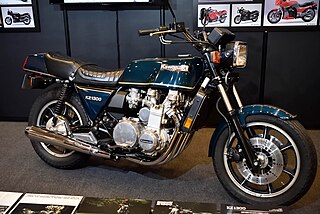
The radial engine is a reciprocating type internal combustion engine configuration in which the cylinders "radiate" outward from a central crankcase like the spokes of a wheel. It resembles a stylized star when viewed from the front, and is called a "star engine" in some other languages.

A straight-twin engine, also known as an inline-twin, vertical-twin, or parallel-twin, is a two-cylinder piston engine whose cylinders are arranged in a line along a common crankshaft.
The Honda XR series is a range of four-stroke off-road motorcycles that were designed in Japan but assembled all over the world.

A U engine is a piston engine made up of two separate straight engines placed side-by-side and coupled to a shared output shaft. When viewed from the front, the engine block resembles the letter "U".

The Vulcan name has been used by Kawasaki for their custom or touring bike since 1984, model designation VN, using mostly V-twin engines ranging from 125 to 2,053 cc.

A motorcycle engine is an engine that powers a motorcycle. Motorcycle engines are typically two-stroke or four-stroke internal combustion engines, but other engine types, such as Wankels and electric motors, have been used.

Axial engines are a type of reciprocating engine with pistons arranged around an output shaft with their axes parallel to the shaft. Barrel refers to the cylindrical shape of the cylinder group whilst the Z-crank alludes to the shape of the crankshaft.

The Kawasaki triples were a range of 250 to 750 cc motorcycles made by Kawasaki from 1968 to 1980. The engines were air-cooled, three-cylinder, piston-controlled inlet port two-strokes with two exhaust pipes exiting on the right side of the bike, and one on the left. It was the first production street motorcycle with capacitor discharge ignition (CDI). Right from the first triple model, the 1968 Mach III H1 500 cc, it was a sales success that gained a reputation for almost unmatched acceleration as well as an air of danger for inexperienced riders trying to cope with the bike's increased power to weight ratio over any previously available stock motorcycles.

The Kawasaki Z1300 is a standard motorcycle unusual for its large-displacement 1,300 cc straight-six engine made by Kawasaki from 1979 to 1989.

The Kawasaki Ninja ZX-9R is a motorcycle in the Ninja sport bike series from Japanese manufacturer Kawasaki, produced from 1994 until 2003. There were five model incarnations across two basic designs.
The Green Engine Co was a British engine company founded by Gustavus Green in Bexhill to sell engines of his design. He flourished especially as a designer of aeroplane engines during the first two decades of the 20th century. The engines were actually manufactured by the Aster Engineering Company.

The Kawasaki W series is a line of vertical-twin standard motorcycles motorcycles made by Kawasaki beginning in 1965. First sold as a 1966 model in the North American market, the initial Kawasaki W1 had the largest engine displacement of any model manufactured in Japan at the time.

The S2 Mach II is a 350 cc Kawasaki motorcycle introduced for the 1972 model year and discontinued at the end of the 1974 model year. It has a 3-cylinder two-stroke engine with a displacement of 346 cc (21.1 cu in), and superseded the rotary disc valve twin-cylinder Kawasaki A7 Avenger.

The Kawasaki H1 Mach III was a two-stroke 500 cc sport bike made by Kawasaki from 1969 through to 1975.

The Kawasaki Mach I was a 250 cc (15 cu in) Kawasaki motorcycle made 1972 through 1975.

The Kawasaki H2 Mach IV was a 750 cc 3-cylinder two-stroke production motorcycle manufactured by Kawasaki. The H2 was a Kawasaki triple sold from September 1971 through 1975.

The Kawasaki A1 Samurai is a 250 cc (15 cu in) standard class Kawasaki motorcycle which was sold from 1967 through 1971.

The A7 Avenger is a 350 cc (21 cu in) Kawasaki motorcycle sold 1967 through 1971.

Bridgestone motorcycles were a division of the Bridgestone Tire Co. of Kyōbashi, Tokyo, Japan that produced mopeds and motorcycles from 1952 to 1970. Initially producing power assisted bicycles, the division moved on to producing mopeds and then motorcycles. The motorcycles were technologically advanced and powered by two-stroke engines. The high technical specification resulted in the machines being more expensive compared to other manufacturers models. Production was stopped in 1970 to protect the supply of tyres to other manufacturers.
















